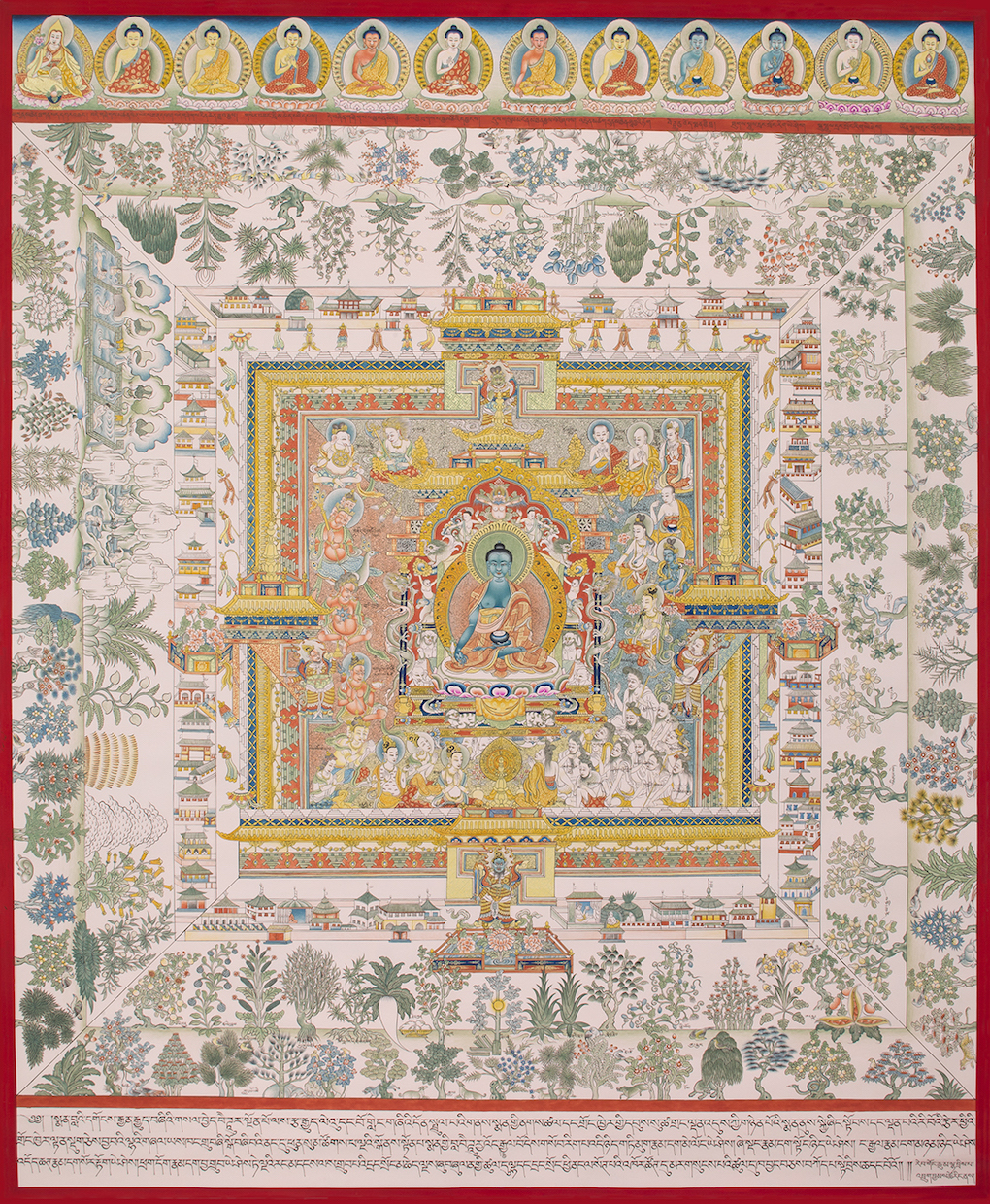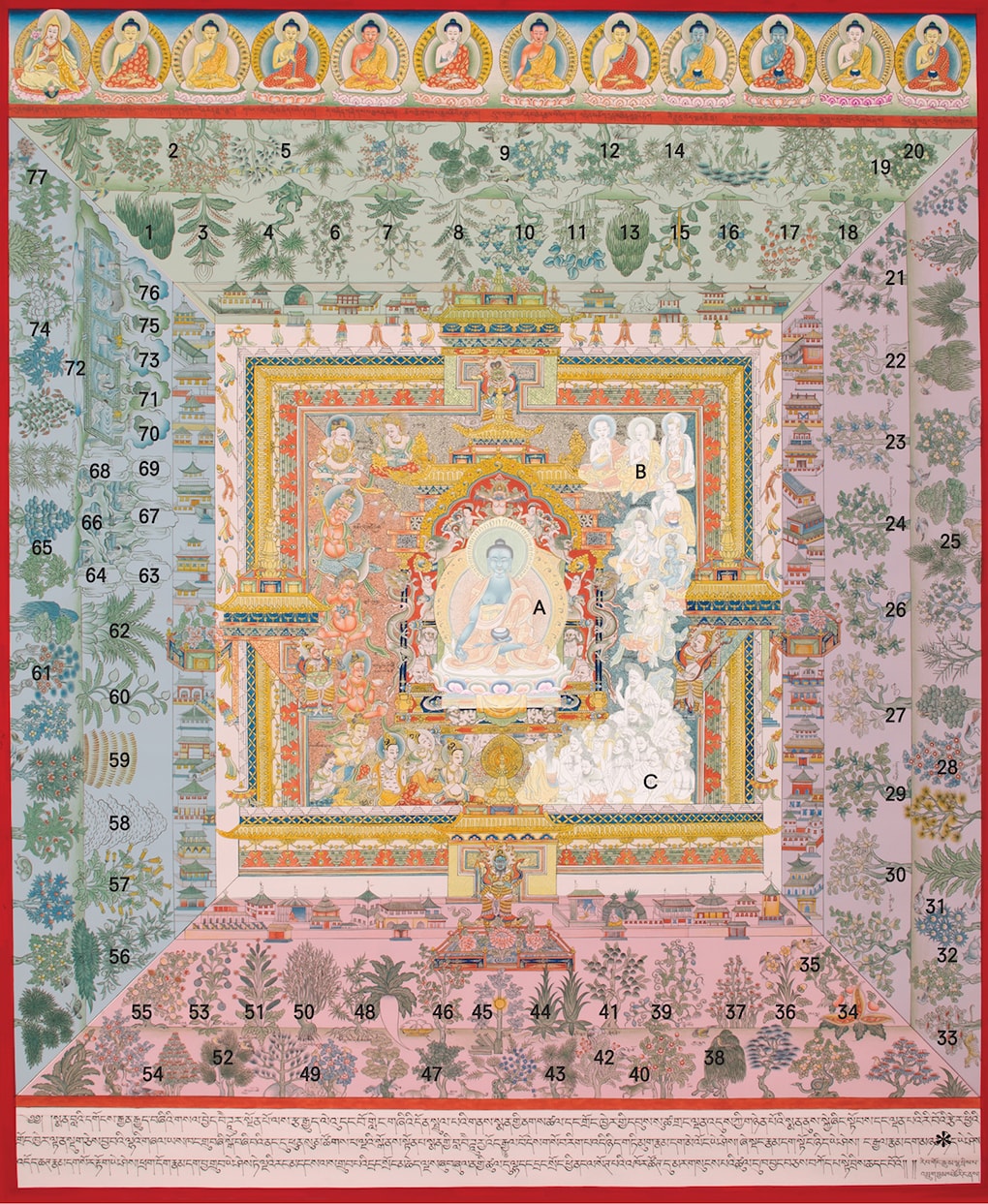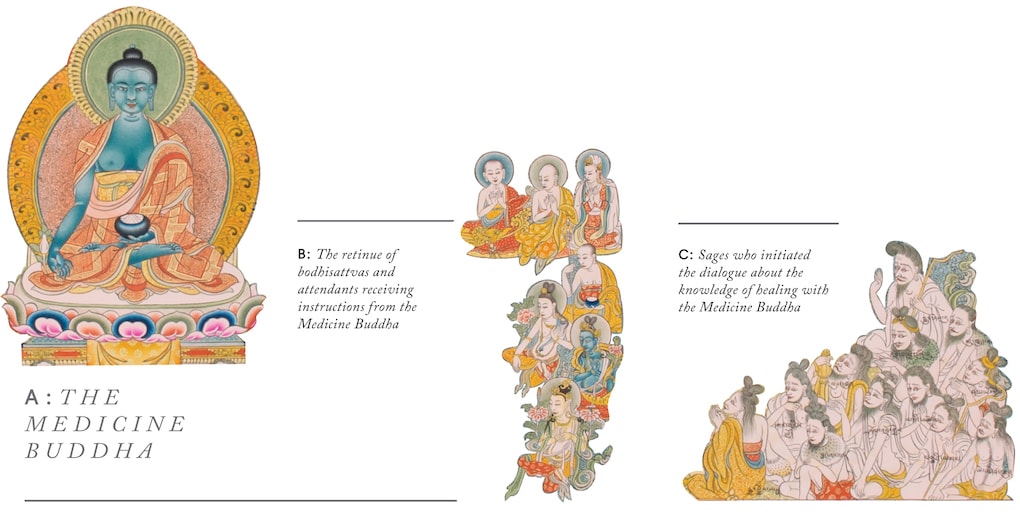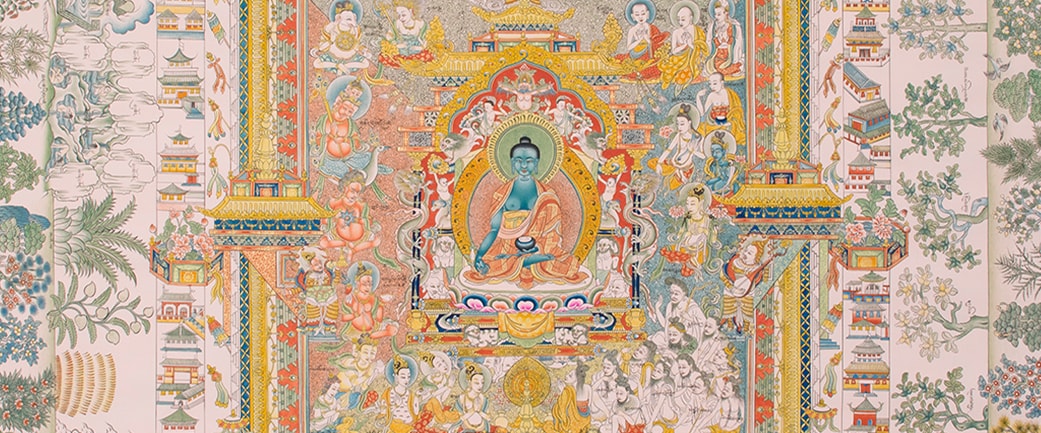
Every plant, mineral, and natural source can be used for healing

Lobsang Drubjam Tsering
Medicine Buddha Palace (copy of first painting from the set of Tibetan Medical Paintings from Mentsikhang Lhasa)
Rebgong county, Qinghai Province, China; 2012″“2013
Pigments on cloth
Rubin Museum of Art
SC2013.6
This painting depicts a specific event: the Medicine Buddha, seated in the center of his mandala palace, explaining the science of healing to four groups of disciples””gods, saints, Buddhists, and non-Buddhists. Yet the painting can also be viewed as a metaphor for the inclusive, holistic nature of Tibetan medical knowledge and practice””representing the entire physical world, where everything can be used for healing, as the story of the medical student Jivaka tells. His master asked him to find a substance or a plant that could not be used as medicine. After a long search, Jivaka returned emptyhanded, but his teacher congratulated him and said his training was complete””now he knew that there is no substance on earth without healing properties.
The Medicine Buddha’s palace is surrounded by four mountains in the cardinal directions. Each is a perfect environment for certain medicinal plants, springs with healing waters, minerals, and precious stones associated with specific curative qualities.


Green Section: Abode of the Northern Himavant Mountains
The Northern Snow Mountain, endowed with the power of the moon, encompasses a medicinal forest of plants that are bitter, sweet, and astringent in taste with cool, blunt potencies that cure hot disorders, such as bile ailments.
- 1: White sandalwood
- 2: Hare
- 3: Camphor
- 4: Eaglewood/aloeswood
- 5: Elephant
- 6: Chinaberry
- 7: Gentian
- 8: Licorice
- 9: Civamcivaka
- [winged creature with bird legs and human torso]
- 10: Coleus leaves
- 11: White aconite
- 12: Saiga antelope
- 13: Red sandalwood [trunk]
- 14: Rhinoceros
- 15: Birthwort [branch]
- 16: Spleenwort [leaf]
- 17: Kapok stamen,calyx, and corolla
- 18: Grape [fruit]
- 19: Sparrow
- 20: Himalayan black bear
Purple Section: Abode of the Eastern Gandhamadana Mountain
The Eastern Fragrant Mountain, endowed with the power of the sun and moon, encompasses a medicinal forest of arura (Terminalia Chebula) plants, a key ingredient in Tibetan medicine. In his palm the Medicine Buddha holds this plant, which is said to be the mythical source of the myrobalan fruit and has seventeen qualities that cure all sorts of disorders.
- 21: “Beak-shaped” myrobalan
- 22: “Golden-colored” myrobalan
- 23: “Small black” myrobalan
- 24: “Dry” myrobalan
- 25: Leopard
- 26: “Enriching” myrobalan
- 27: “Nectar” myrobalan
- 28: Peacock
- 29: “Fearless” myrobalan
- 30: “Victorious” myrobalan
- 31: Sparrow
- 32: Saiga antelope
- 33: Tiger
Pink Section- Abode of the Southern Vindhya Mountains
The Southern Piercing Mountain, endowed with the power of the sun, encompasses a medicinal forest of plants that are hot, sour, and salty in taste with hot, sharp potencies that cure cold disorders, such as phlegm ailments.
- 34: Bonducella fruit
- 35: Civamcivaka
- [winged creature with bird legs and human torso]
- 36: Buttercup [flower]
- 37: Rhododendron [leaf]
- 38: Eurasian cuckoo
- 39: Clematis [branch]
- 40: Himalayan black bear
- 41: Pine tree trunk
- 42: Parrot
- 43: Saiga antelope
- 44: Cassia
- 45: Cinnamon
- 46: Sumach
- 47: Musk deer
- 48: Asafoetida
- 49: Elephant
- 50: Capsicum
- 51: Long pepper
- 52: Sparrow
- 53: Black pepper
- 54: Peacock
- 55: Pomegranate
Blue Section: Abode of the Western Malaya Mountain
The Western Garland Mountain, endowed with the power of the sun and moon, is the source of six superlative medicines, among others, and where medicinal waters and hot springs abound.
- 56: Nutmeg
- 57: Clove
- 58: Bamboo pith
- 59: Saffron
- 60: Cardamon
- 61: Monkey
- 62: Cubeb/greater cardamom
- 63: “Girl” limestone
- 64: “Neuter” limestone
- 65: Deer
- 66: “Five medicinal springs
- 67: “Boy” limestone
- 68: “Male” limestone
- 69: “Female” limestone
- 70: Dark lead bitumen
- 71: Iron bitumen
- 72: Five kinds of hot springs
- 73: Copper bitumen
- 74: Tibetan elk
- 75: Silver bitumen
- 76: Gold bitumen
- 77: Peacock

*A translation of the caption at the bottom of the painting:
“From the Blue Beryl treatise, The Ornament of the Intention of Bhaisajyaguru, Master of Remedies, explaining the Four Medical Tantras. This painting illustrates the first chapter of the Root Tantra, The Introductory Scene. At the center of an emanational abode amid the medicinal forest called Bhaisajyavana, on the summit of a mountain endowed with potent and powerful remedies, within a celestial palace with four gates, the Teacher of Remedies (Bhaisajyaguru) explains the science of medicine to many assembled gods, hermit sages, Hindu divinities, and Buddhists. The teaching is given in the form of a dialogue between the hermit sages who are the natural brilliance of the five types of pristine cognitions””the mirror-like pristine cognition which purifies delusion, the pristine cognition of emptiness which purifies hatred, the pristine cognition of sameness which purifies pride, the pristine cognition of discernment which purifies desire, and the pristine cognition of accomplishment which purifies envy.”
About the Contributor
Elena Pakhoutova is a senior curator of Himalayan art at the Rubin Museum of Art and holds a PhD in Asian art history from the University of Virginia. She has curated several exhibitions at the Rubin, most recently The Second Buddha: Master of Time (2018) and The Power of Intention: Reinventing the (Prayer) Wheel (2019).


